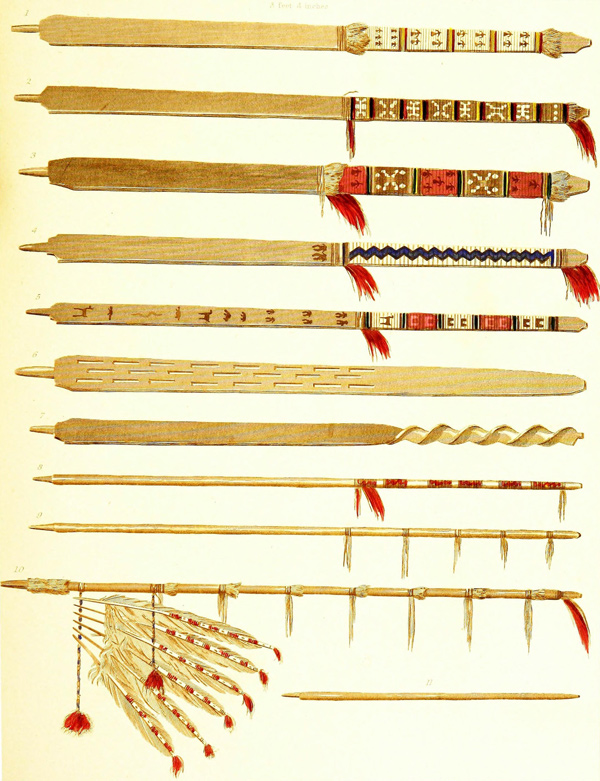The morning brings snow and rain as the boats make seven more miles up the Missouri. Near present Washburn, North Dakota, the captains and Arikara chief Too Né are greeted by a Mandan chief and with great cordiality and ceremony, smoke the pipe.
Early Start
Set out early a Cloudy day Some little Snow in the morning I am Something better of the Rhumutim in my neck— a butifull Countrey on both Sides of the river. The bottoms Covd. with wood, we have Seen no game on the river to day a prof of the Indians hunting in the neighbourhod
—William Clark
Mandan Cordiality
passed a Island on the S. S. made by the river Cutting through a point, by which the river is Shortened Several miles— on this Isld. we Saw one of the Grand Chiefs of the Mandins, with five Lodges hunting, this Cheif met the Chief of the Ricares who accompanied us with great Cordiallity & Sermony Smoked the pipe
—William Clark
Of the decorative pipe stems in the figure, ethnographer Henry Schoolcraft wrote:
The Indian pipe has a flat wooden stem, about three feet and a half long, which is elaborately and tastefully ornamented with native pigments, dyed porcupine-quills, birds’ feathers, colored hair, or pendent feathers. . . . In figure 6, which is a plain flat stem, the object is to excite wonder how the pith of the wood should not interfere with the quadrangular perforations. This is accomplished by tracing a waving channel on two corresponding thin, flat pieces, which are afterwards glued together, and the line of junction concealed with paint. Sometimes, however, this stem is made from a single piece, having a crooked pith.
No. 10 represents the Chippewa and Dacota pipe-stem, ornamented with the scalp of the male duck’s head, and having five pendent feathers, with the quill ornamented with thin splits, worked with porcupine. This is called the peace pipe. No. 11 is the simplest kind of stem.[1]Henry R. Schoolcraft, Information Respecting the History and Condition and Prospects of the Indian Tribes of the United States (Philadelphia: Lippencott, Grambo & Co., 1852), 2:512.
Weather Diary
Thermot. at rise
Weather Wind at rise
thermotr. at 4 P.M. Weather Wind at 4 oC P.M. 33 snow after fair N. W. 51 cloudy after snow N W arrived at a mandane [Mandan] hunting camp visited the lodge of the chief
—Meriwether Lewis[2]To assist the reader, the editor of this web page has omitted the “day of the month” column and spelled out some abbreviations.
Notes
| ↑1 | Henry R. Schoolcraft, Information Respecting the History and Condition and Prospects of the Indian Tribes of the United States (Philadelphia: Lippencott, Grambo & Co., 1852), 2:512. |
|---|---|
| ↑2 | To assist the reader, the editor of this web page has omitted the “day of the month” column and spelled out some abbreviations. |
Experience the Lewis and Clark Trail
The Lewis and Clark Trail Experience—our sister site at lewisandclark.travel—connects the world to people and places on the Lewis and Clark Trail.
Discover More
- The Lewis and Clark Expedition: Day by Day by Gary E. Moulton (University of Nebraska Press, 2018). The story in prose, 14 May 1804–23 September 1806.
- The Lewis and Clark Journals: An American Epic of Discovery (abridged) by Gary E. Moulton (University of Nebraska Press, 2003). Selected journal excerpts, 14 May 1804–23 September 1806.
- The Lewis and Clark Journals. by Gary E. Moulton (University of Nebraska Press, 1983–2001). The complete story in 13 volumes.


